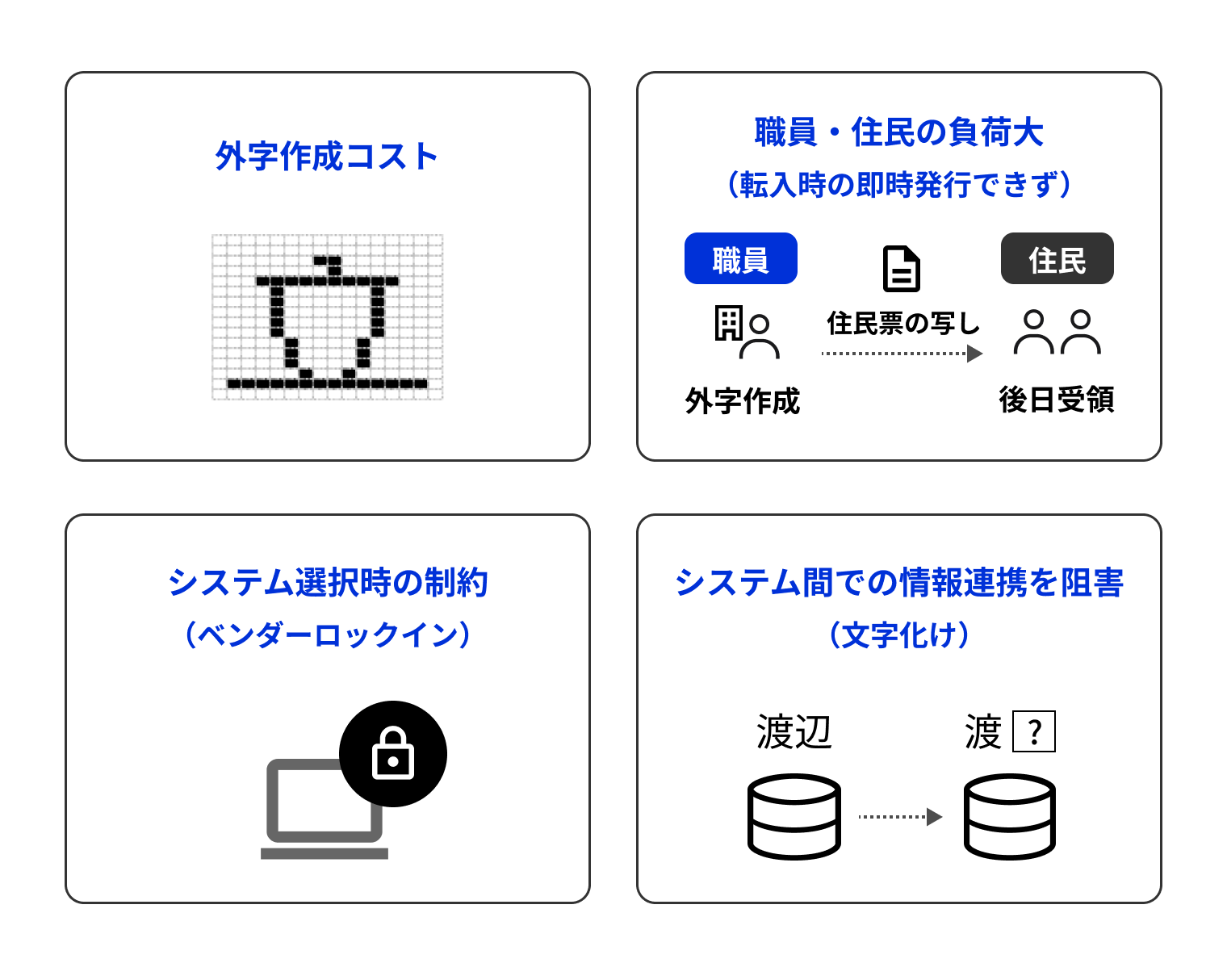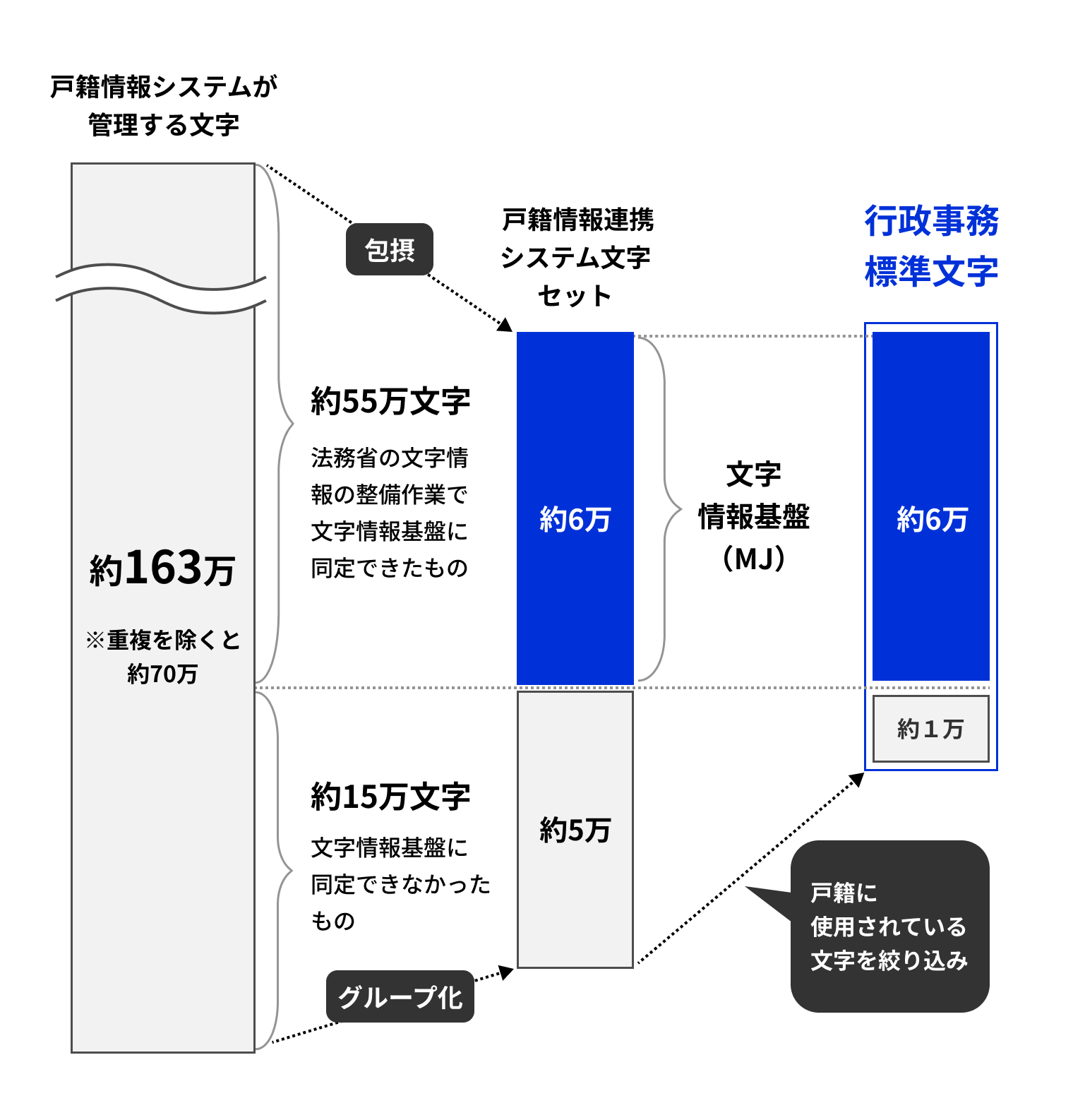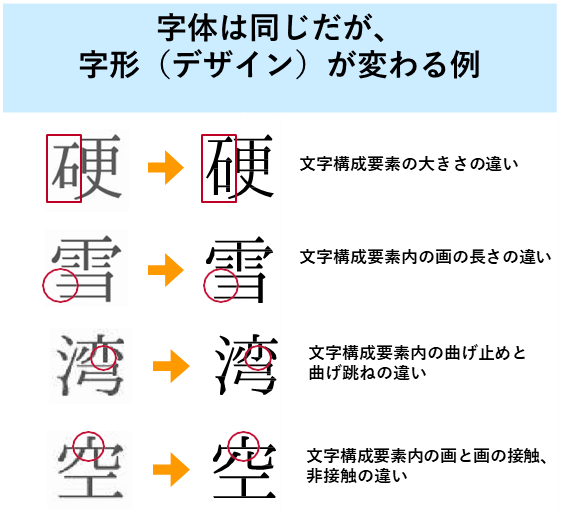Standardization of characters in local government information systems
- Last Updated:
As part of the efforts to unify and standardize the mission-critical systems of local governments, we are promoting character standardization, including the standardization of the Gaiji . We aim to improve the efficiency and improved services for residents of administrative work by making data management and information coordination between systems easier.
Table of Contents
- Introduction of standard characters for administrative work
- Background to the Need for Character Standardization
- Formulation of standard characters for administrative work
- Impact of character standardization
- References
- Frequently Asked Questions
- Conference and
- Related Information
Introduction of standard characters for administrative work
Based on the Act on Standardization of Local Public Authorities' Information Systems (Act No. 40 of 2021), we are working on the "Unification and Standardization of standardization, there are transitional measures that enable the use of conventional character sets, character codes, and character fonts for the family register and Supplementary Family Register (Family Register Information System and Supplementary Family Register System) by maintaining the correspondence of conventional character sets with standard administrative characters. ," which will standardize the specifications (functional requirements, data requirements, etc.) of information systems used by local public authorities across the country for operations targeted for standardization (Unification and standardization of mission-critical systems for local governments) from the perspective of commonality in the content of administrative processing, improvement of residents' convenience, and efficiency of local government operations.
As part of this effort, we are preparing to standardize the characters used in systems that meet the standard specifications (standard compliance system) in cooperation with local governments and system vendors. We aim to improve the efficiency and improved services for residents of administrative work by formulating and introducing administrative work standard characters and facilitating data management and information linkage between systems.
In addition, the "Study Group on the Operation of Text Requirements for Local Government Information Systems" was established in FY 2023, and the "Expert Committee on the Standardization of Text in Local Government Information Systems" was established in FY 2024. We are studying issues related to the operation of text requirements with experts. For details, please check with the Conference and .
Background to the Need for Character Standardization
What is a user-defined character?
Behind the demand for character standardization is the existence of external characters. External characters are characters that are created individually based on whether the lines that form the character are connected or separate, as well as the length and direction of the lines. A characteristic of external characters is that they are mostly used for personal names.
This is a symbol of the richness and depth of Japanese character culture, but at the same time, it has been a heavy burden for public institutions because mis-input and mis-confirmation of names are not allowed. There have also been cases of abuse such as fraudulent acts targeting people who do not notice the small differences in characters.
Resolving the Various Problems Associated with Private Characters
The main issues with private characters are:
- Cost of creating private characters
- Text data is created and maintained by each local government and by each division within a local government that carries out procedures.
- Heavy burden on local government employees and residents
- You can't issuing on the same day a Copy of Resident Record when you move in. After an employee of the local public entity creates the private characters, the resident will receive a Copy of Resident Record later.
- In the case of public institutions such as local governments, a large burden arises in the confirmation work to prevent the occurrence of name input errors during procedures.
- The fact that different types of characters are managed by computers in each local government hinders the implementation of efficient administrative services and rapid response in the event of a large-scale disaster.
- Limitations when selecting a system (vendor lock-in * 1)
- When updating a system, user-defined characters become an obstacle, and it is easy to end up in a state of vendor lock-in where users continue to rely on the same vendor. This is also a factor in the high cost of creating, maintaining, and managing characters.
- Interference of information between systems
- Since the data on computers used for services for residents are managed by different systems, if external characters are used, not only data linkage between different local governments but also data linkage between systems in different departments within the same local government can result in garbled characters, etc., which is a factor that hinders information linkage.
* 1 Vendor lock-in: A phenomenon in which it becomes difficult to switch to another vendor when products, services, systems, etc. that rely heavily on the proprietary technology of a specific vendor are adopted.

Examples of Data Linkage in Public Services
Currently, computers used for public services are managed by different systems. We issue your postal mail and Various Certificates by linking the different systems. For example, the following certificates are issued by linking the different systems.
| Certificate Image | System of the cooperation origin | System that outputs the certificate |
|---|---|---|
| Attachment copies of family register | Resident record system | Supplementary Family Register system |
| Medical Examination Forms for Medical Examinations, Cancer Screenings, etc., and Prevaccination Screening Forms, etc. | Resident record system | Health care system |
| Certificate of qualification | Resident record system | National Health Insurance System |
Formulation of standard characters for administrative work
The Origin of Standard Characters for Administrative Work
According to a survey by Ministry of Justice, the Family Register Information System of municipalities manages about 1.63 million characters, or about 700,000 characters excluding duplicates. Of these, about 550,000 characters were successfully organized as the same characters as those of the Character Information Platform (MJ) * 2, which covers about 60000 characters among the character sets of the Family Register Information Linkage System in Ministry of Justice. Therefore, we decided to use the Character Information Platform (MJ) as the base when considering characters for standard compliance system.
The remaining approximately 150,000 characters could not be sorted out as the same characters in the Kanji Character Base (MJ). However, when we narrowed down the characters actually used in the family register, we were able to identify approximately 10,000 characters. Together with the existing Kanji Character Base (MJ), Digital Agency established approximately 70000 characters as the "administrative standard characters."
Digital Agency is studying the international standardization of administrative standard characters to ensure that characters are compatible and can be used widely without hindering information sharing.
* 2 Kanji Character Infrastructure: The Kanji Character Infrastructure was formulated in 2011 to cover standardized characters for family registration and standardized characters for Basic Residential Registers Network System so that the names of all Japanese citizens can be handled by computers. In June 2013, the "Proclamation to be the World's Most Advanced IT Nation" was approved by the Cabinet, and its usage policies were made a principle. The project to develop and internationally standardize approximately 60000 kanji characters used in administrative work that require accurate writing of names and other information is called the Kanji Character Infrastructure. The Kanji Character Infrastructure Development Project is an initiative to reduce the number of characters that cannot be used. The characters developed through this project are called MJ characters. International standardization is also being conducted using fonts based on the Kanji Character Infrastructure. The Kanji Character Technology Promotion Council provides character fonts and a list of character information free of charge. The total number of characters is 58862.

Impact of character standardization
The appearance of characters used by local governments for mailing addresses, etc. may change.
From FY 2025, the characters used in Various Certificates and postal items will be gradually standardized through the unification and standardization of characters used in standard compliance system. For those who use their own private characters (characters that cannot be expressed on standard PCs) for their names, etc., the characters used for Various Certificates issued by local governments and for addresses, etc. of postal items mailed from local governments will be output as "administrative standard characters," and the design may be different from the past. The framework of Chinese characters (called "character style") will not change, but they may change within the range of differences in design (differences in "character shape") such as the size of radicals, differences in bending, and differences in some lengths. The start date of introduction and the types of certificates and postal items subject to the introduction will vary depending on the situation of each local government. In addition, we are making it known through related organizations in August 2025 that when the appearance of characters such as names differs between Various Certificates and postal items issued by local governments and other documents, they will not be required to submit additional identity verification documents at administrative counters or in identity verification situations at private sector.
On the family register, we keep the traditional script.
In the process of standardization, the existing characters will continue to be used in the family register * 3. The standard characters for administrative work are those used in certificates issued by local governments, printed materials, and computer processing, etc., and the names written by hand on documents, etc. can still be used.
* 3 Among the 20 administrative areas subject to standardization, there are transitional measures that enable the use of conventional character sets, character codes, and character fonts for the family register and Supplementary Family Register (Family Register Information System and Supplementary Family Register System) by maintaining the correspondence of conventional character sets with standard administrative characters.

References
- Text Subsumption Guidelines
For the standardization of mission-critical systems, guidelines were established to determine whether characters can be included in standard characters for administrative work as a reference when local governments perform identification work on standard characters for administrative work.- Word Connotation Guidelines (PDF / 2,804 kb) (updated July 18, 2025)
- List of Characters and Graphics of Standard Administrative Characters
Administrative affairs Lists the entity names and entities found in the standard text. See the Character Subsumption Guidelines for definitions of "entity name" and "entity."- List of Characters and Graphics of Standard Administrative Text (PDF / 62,477 kb)
*The graphic name of MJ-characters in the table and the basic characters of character information shown in the table are based on MJ-character information table ver. 006.02. MJ-character information table is a copyrighted work of IPA and provided by Commons attribution - SHARE-aLIKE 2.1 (Attribution-ShareAlike) (Creative Commons) .
- List of Characters and Graphics of Standard Administrative Text (PDF / 62,477 kb)
- Materials for the Introduction of Standard Characters for Administrative Work
A leaflet was created after discussion in the Advisory Council on the Standardization of Characters in Local Government Information Systems.
Frequently Asked Questions
Conference and
- Study Group on the Operation of Character Requirements for Local Government Information Systems
- Advisory Council on Character Standardization for Local Government Information Systems
Related Information
- Unification and standardization of mission-critical systems for local governments
- MJ Textual Information List (Textual Information Technology Promotion Council)
- "Concerning the Concept of' Font, Style, and Form' in list of Kanji for common use" (Cultural Affairs Agency)
- Character Development Project (Ministry of Justice)